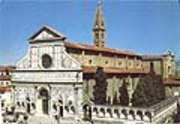Firenze — Santa Maria Novella
Chiesa di Santa Maria Novella

As is the case with most other Florentine squares, Piazza Santa Maria Novella is dominated by its church. The facade is one of the earliest and most beautiful in Florence. It was begun about 1300, and the lower part reveals the influence of both the Baptistery and San Miniato al Monte, while the main door and the upper half, with its graceful curves, are by Leon Battista Alberti, and date to 1470. The two astronomical instruments on the extremities of the facade were added by Cosimo I De'Medici's astronomer in 1572.
The inside of the church, which is simply vast, has a number of important art works. Off the right transept there is the Rucellai Family chapel, which used to have a Madonna with child by Duccio (it's now in the Uffizzi), and still has a Madonna with Child by Nino Pisano.
Still on the right transept, next to the apse, is Filippo Strozzi's chapel, with frescoes of the Old Testament (on the vault) and the lives of the saints, by Filippino Lippi. The frescoes on the apse behind the main altar, are, instead, Domenico Ghirlandaio's masterpiece, stories from the life of the Virgin; he worked on them from 1485 to 1490 with the help of his brother, brother in law, and a bevy of assistants, including the young Michelangelo.
The Gondi Chapel, immediately to the left of the altar, contains Brunelleschi's only surviving sculpture, a crucifixion he is said to have done sometime between 1410 and 1425, to show Donatello how he thought the Savior should be rendered.
The Strozzi Family chapel, which is off from the left transept, has an interesting fresco cycle of the Divine Judgment, with paradise and hell that reveal Dante's influence, done by Nardo di Cione, Andrea Orcagna's brother, in about 1357. Andrea did the Redeemer and Saints in 1357. Continuing down the left transept, you will come to Masaccio's Trinity, with Mary and Saint John. The fresco, painted in 1427, is one of the most important early Renaissance works, because of the control employed in positioning the figures, and because it is one of the first to accurately render perspective (Brunelleschi may have advised Masaccio). The skeleton lying on a bench below the Trinity bears the warning, 'I was what you are, and am what you yet shall be.' The entrance to the cloisters (Santa Maria Novella was a Dominican monastery) is to the right of the main door as you exit the church, and is well worth visiting.
The refectory has the Creation of Adam and the animals, and the Creation and Temptation of Eve, by Paolo Uccello, as well as his masterpieces, the Flood and the Sacrifice of Noah, in which he astonished his contemporaries with his skill in rendering perspective. Among the many other frescoes in the cloisters, there is, in the Cappellone degli Spagnoli, the hall that the Spaniards in the retinue of Duchess Elenore of Toledo, consort to Cosimo I De'Medici, used for religious services, an enormous allegorical fresco of the Militant Church, in which God's Watch dogs, Dalmatians and Dominican monks, watch over the flock of the faithful and savage wolves and heretics. Behind the Cappellone degli Spagnoli is the Chiostrino dei Morti, a small cloister with frescoes from the 14th century.